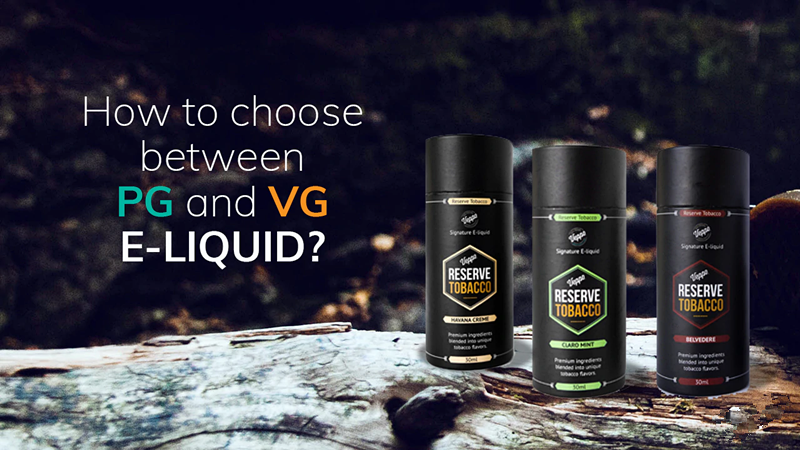
If you’re looking to make the switch to electronic cigarettes, you’re probably curious about the ingredients in e-liquid.
Vaping terminology can be a bit confusing at first, so in this article I’m going to try and explain the differences between the two most widely used e-liquid bases: propylene glycol (PG) and vegetable glycerin (VG).
Here's a quick breakdown in a chart, and I encourage you to read the important information below it as well.

Ingredients in E-liquid
The premium e-liquids contain four main ingredients: a PG or VG base, nicotine, water and food grade flavorings.*
** Diacetyl-free and Vit E Acetate-free **
All VEPPO eliquids are Diacetyl-free and contain no Vit E Acetate.
The base, or carrier, holds the nicotine and flavor in suspension so your e-cigarette or vaporizer can produce those nice clouds of smoke-like vapor.
Both propylene glycol and vegetable glycerin are non-toxic organic compounds and generally considered safe for consumption by the FDA. In fact, they are widely used as food additives in a variety of commercially available food and personal care products. Like ketchup? There's propylene gylcol in it.
PG e-liquid

First, let’s talk about PG-based e-liquid, because it’s the most popular of the two.
Thinner Consistency: Due to the fact that propylene glycol has a runny consistency, PG e-liquid is thinner than the VG variety, and is easily absorbed by the polyfill and cotton fabric inside cartomizers and wick tanks.
Less Gunk: The low density of the juice also means that gunk doesn’t build up on the heating element of your vaporizer as fast as it does when thicker vegetable glycerin liquid is used.
Does not affect flavor: Propylene glycol is a tasteless odorless substance, so it doesn’t alter the flavor of the e-liquid in any way.
Stronger throat hit: It’s also a powerful humectant, so while it will dry your mouth and throat if used consistently, PG also produces a stronger throat hit, similar to that of tobacco cigarettes.
Allergy Risk: On the down side, propylene glycol has been known to cause allergic reactions in some e-cig users. These can vary from minor reactions, like a tingling sensation in the throat, to serious irritations on various parts of the body. If you experience any unusual symptoms after vaping PG e-liquid, it’s best to stop using it immediately and switch to vegetable glycerin. Consult your doctor if necessary.
VG E-liquid
Have you seen images of vapers with large billowing stacks of vapor? They're using a VG base for that effect.
Thicker: Vegetable glycerin is a considerably thicker solution, compared to propylene glycol. It has a slower absorption rate for wicks and cartomizers.
More gunk: Because of it's thick consistency, VG tends to gunk up and clog vaporizers, requiring more cleaning.
Sweeter: On its own, VG has a slight sweet taste which also makes the e-liquid sweeter and the flavors a little difficult to detect.
Allergy Risk: While PG is know to give users a dry mouth, some vapers have complained about phlegm building up in their throat after using vegetable glycerin-based juices. Some vapers switch to VG due to allergies with PG. VG tends to be less allergenic.
Less throat hit: You also get less of a throat hit when using VG.
More vapor: On the upside, because of its thick consistency, VG e-liquids produce significantly more vapor and doesn’t cause allergic reactions or irritations as often as propylene glycol.
How to choose between VG vs PG E-liquid?
PG e-liquid tends to give you a better throat hit and a lot more flavor. Most of Veppo’s premium e-liquid is 100% PG based. VG e-liquid on the other hand, allows your atomizer to produce a lot more vapor. VG e-liquid is a thicker and more sticky fluid, and although most people do not show signs of allergy with VG, there are minority groups who complain about having phlegm buildup in their throats. The more VG e-liquid you use, the less of a throat hit you’re going to get – that’s the general idea.
The vaping community is evenly divided when it comes to e-liquid preference. Some enjoy the intense throat hits more than flavor and vapor, others enjoy the sweet, thick plumes of vapor.
We suggest starting with PG eliquid, especially if you are looking for an experience similar to smoking.
Can I mix PG and VG?
Yes! 60 / 40 mix of VG and PG in your e-liquid can produce great vapor and more flavor. If you like, you can tend to use mix of both PG and VG in particular ratios, such as 70 VG / 30 PG. This is the optimum ratio for most each uses as it provides a nice throw hit, good flavor as well as tons of vapor production.
Vegetable Glycerin (VG) : more vapor, less throat hit.
VG e-liquid is thick and a little sweet. It produces luscious clouds of vapor. VG e-liquid also imparts a sweeter taste to your liquid. (VG eliquid is available in Tobacco and Menthol flavors).
Propylene Glycol (PG) : better throat hit and flavor.
PG e-liquid is thinner and produces more of a “throat hit” than VG e-liquid does, which simulates the feel of smoking better. PG e-liquid also has a higher rate of sensitivity for some people, meaning that some people just can't use PG in their vape. Usually side effects are mild allergy symptoms.
Is PG or VG safer to inhale?
Both VG and PG are used in a variety of foods that you consume on a daily basis, and are deemed safe by the FDA. However, in some small cases, people have experienced allergic reactions to propylene glycol; the most common is skin rash.
So which is better, VG or PG?
The answer is “neither” – you will need both in most cases, to get the best of both worlds. Some prefer vaping 100%VG-only and some 100% PG-only liquids.
